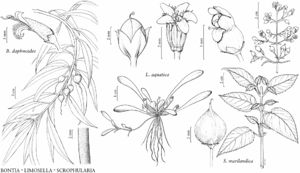Difference between revisions of "Bontia daphnoides"
Sp. Pl. 2: 638 [.
FNA>Volume Importer |
FNA>Volume Importer |
Revision as of 18:29, 24 September 2019
Plants 1–5 m. Bark tan, smooth in young shoots, furrowed in older shoots. Leaves spirally arranged, concolorous, 65–130 × 13–19 mm; petiole 2–7 mm; blade narrowly elliptic, midvein conspicuous, apex acute. Flowers: calyx lobes 3 × 3 mm, margins ciliate, apex acuminate; corolla 15–20 mm; stamens exserted, assurgent against adaxial lip of corolla, anther dehiscence introrse; style elongate. Fruits greenish yellow, 12–15 × 10–12 mm, pedicel and style persistent, exocarp glossy, glabrous, mesocarp corky, endocarp woody. 2n = 36.
Phenology: Flowering Nov–Jun.
Habitat: Coastal thickets, littoral or mangrove forests.
Elevation: 0–10 m.
Distribution
Fla., West Indies, South America.
Discussion
Bontia daphnoides was first discovered in Florida in the early 1990s (S. Zona 1998). Field studies are needed to determine whether flowers are pollinated by bees (as postulated by Zona), hummingbirds (R. J. Chinnock 2007), both, or neither. The fruits float and are adapted to dispersal by water. Bontia daphnoides has potential as an ornamental shrub, especially because it tolerates alkaline soil, salt, and drought. It is used medicinally throughout much of the Caribbean (E. S. Ayensu 1981b).
Selected References
None.
